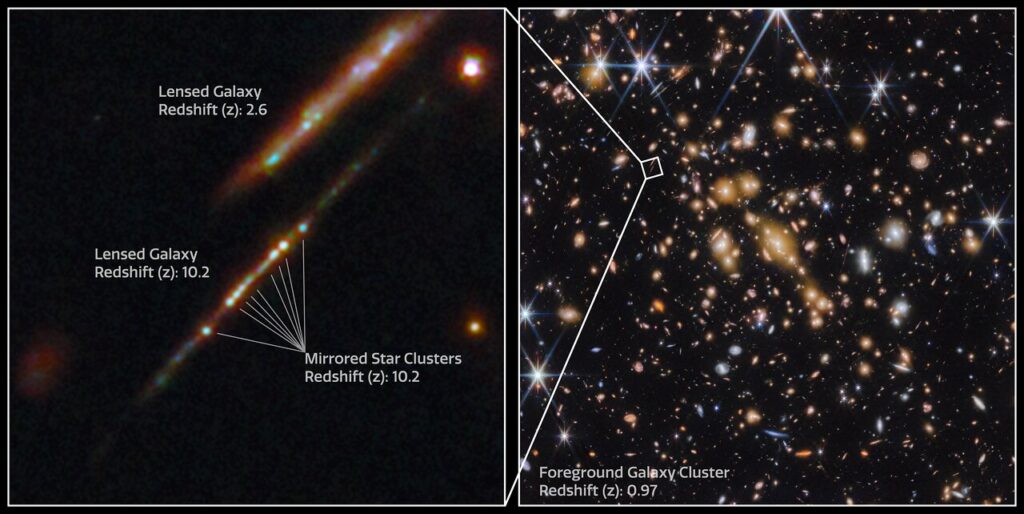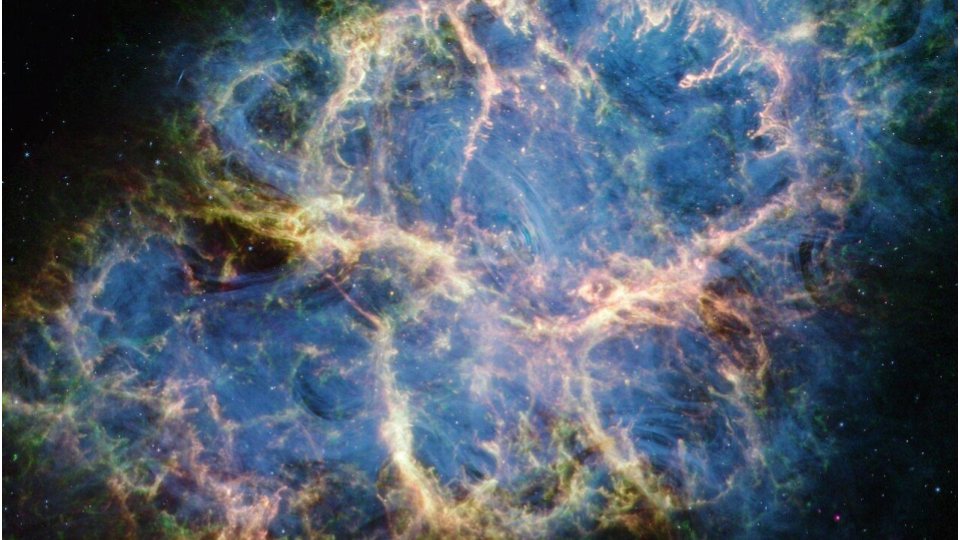
The interstellar medium is not my favorite topic in astronomy. Fundamentally, it is the study of interstellar dust bunnies – those clumps of gas and dust that clog up our skies and block our ability to see more distant stars and galaxies. They don’t vary like the pulsating stars I love most. They don’t have stories that alter how we understand our universe like galaxies and galaxy clusters. The gas and dust between stars are just transient blobs of material – sometimes bright and sometimes dark – that are either released during stellar death or waiting to form new stellar life.
The thing is, infrared telescopes like the JWST are changing how we see the interstellar medium. In these longer wavelengths of light, formerly opaque clouds are now semi-transparent regions. What was once just a hole in the sky can now be seen as interesting star-forming regions or other vibrant locations rich in never-before-seen dynamics. Regions that were once just bright blobs are now getting resolved into individual stars that are as active as the active galactic nuclei I love… just at smaller scales.
In this closer look, we will look at some of our new views on the sky, revealed by our new IR views on nebulae.
Star formation all lined up

Theorists have long stated through maths and computer simulations that a collapsing cloud of gas and dust should spin up, and transfer its momentum to its fragmenting solar nebulae that in turn form aligned young stars. This isn’t to say an entire star-forming region has totally aligned stars. Rather – one collapsing section will fragment into co-aligned fragments.
It all makes sense, we’ve been saying it for years… but we didn’t have evidence this was true until now.
Thanks to the JWST, researchers now have the resolution to see if this theory is true … and researchers looking at stars forming in the Serpens Main star-forming region have identified a region with 20 candidate protostellar outflows that all seemed to be the same age and also aligned to within +/- 24 degrees. They estimate the probability of this randomly happening is 1 in 10,000.
This alignment isn’t chance – this is science!
Where there was thought to be one, we now see two

Sepens Main is a star-forming region is just 1-2 million years old, and it is just one of many star-forming regions JWST is peering into.
Deep in the Rho Ophiuchus star-forming region is a long-studied knot of star formation cataloged as WL 20. The young stars are only 2-4 million years old and detailed images of this system can be used to better understand star formation… only it turns out that one of those stars we’ve been studying is actually two stars!
In optical telescopes, these stars are entirely hidden by opaque gas and dust, but in prior IR images, it looked like 2 hotter stars and one cooler star. The new JWST Mid Infrared Instrument images reveal the cooler star, WL-20S, is actually two stars that each have hints of stellar jets.
This work was presented by Mary Barsony at the American Astronomical Society Meeting. She notes, “After studying this source for decades, we thought we knew it pretty well. But without MIRI we would not have known this was two stars or that these jets existed. That’s really astonishing. It’s like having brand new eyes.”
Leveraging their JWST discoveries, the team went on to get Atacama Large MM/SubMM observations that were more sensitive to the light coming from the stellar jets.
The combined data shows WL-20S is a pair of stars with aligned disks and aligned jets – a binary star system forming together just as theory always said we should see.
As an astronomer, I look at the resulting images and am just in awe at the details, but one remarkable illustrator took the science image and translated it into an illustration that science beautifully rendered to make what’s going on clear to everyone.
Resolved: Early-universe star formation

JWST’s ability to show us new things spans from what is cosmically in our backyard and all the way out to the most distant corners of our universe.
Consider, for instance, the galaxy SPT0615-JD1. This early system shines from when the universe was just 460 million years old. It was first discovered as a streak of light in a Hubble Space Telescope image; just another gravitationally lensed object that has its light magnified and distorted by the gravity of a massive galaxy cluster.
With JWST’s higher resolution and larger light-gathering capacity, HST’s smudge resolved into numerous knots of light.
This work appears in a new paper in Nature led by Angela Adamo. She explains, “The surprise and astonishment was incredible when we opened the Webb images for the first time. We saw a little chain of bright dots, mirrored from one side to the other — these cosmic gems are star clusters! Without Webb we would not have known we were looking at star clusters in such a young galaxy!”
These systems are consistent with proto-globular clusters – star systems that are gravitationally bound together that will experience just one burst of star formation and then travel through history together as an aging family of stars. We know from looking at nearby globular clusters that these are systems formed early in the universe, but we hadn’t realized previously what an important role they played.
Adamo further explains, “These results provide direct evidence that indicates proto-globular clusters formed in faint galaxies during the reionization era, which contributes to our understanding of how these galaxies have succeeded in reionizing the Universe.”
The early universe cooled from an early state of hot fully-ionized gas to cool, neutral gas state. Neutral gas can’t generally be seen through, and we know that at some point in history, ultraviolet light from hot stars ionized the neutral gas, making our universe transparent. One of the justifications for building JWST was to try and directly observe this process.
These images are just the starting point in this team’s research. Next, they look forward to looking at this system with JWST’s spectrometer. This will confirm the system’s distance and allow them to get additional insights on the system’s physical properties and star formation rates.
And when their results are out, we’ll bring them to you right here on EVSN.
Gas, gas everywhere, telling cosmic stories

Today we’ve focused on star-forming regions. We could just as easily have talked about the beautiful chaos of gas and dust that are shaped by stellar death. JWST’s latest image of the Crab Nebula, for instance, is allowing astronomers to see details that honestly leave us just that much more in awe of this amazing structure. It was originally thought the supernova that went off in 1054 might have been a rare electron-capture supernova. The idea that the 1 supernova that was both super nearby and … as far as supernovae go… fairly recent … happened to be a rare kind of supernova hasn’t sit well with astronomers. We like to think we don’t exist in a special time or place, and just like I can’t count on winning the lotto to solve my funding issues, we can’t count on rare events to occur where they are easy to study. Sure … I might win… and a rare SN might have gone off cosmically nearby… it’s just unlikely. … And with the new JWST data the nebula not only looks better than we’ve ever seen it, but we are also finding that its data is completely consistent with it being a totally normal core-collapse supernova that was caused by a large star filling its nucleus with iron before going boom. It probably was a star on the small side, as far as the range of truly massive, exploding stars go, but it was likely just a normal event, occurring as they do.
And with more data, we should gain a deeper understanding of not just nebulae but so many other things as well. In the next few years, we’re going to start seeing some of the world’s next-generation telescopes – systems with mirrors tens of meters across – begin to make observations. These new systems and the new advanced optics that are getting installed on systems like the Large Binocular Telescope are going to allow us to get images as clear as Hubble’s… or better… with the kinds of sensitivities Hubble’s small mirror never allowed. We are on the edge of something amazing…
It’s just going to be amazing with a side of communications satellite, but the problems with StarLink, OneWeb, and all the mega-constellations is a story for another day.
